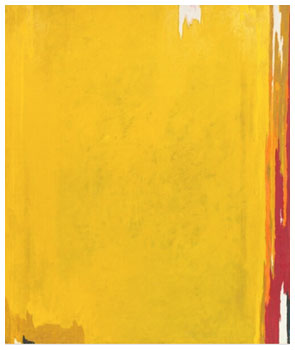 Jackson Pollock once said, “Clyfford Still makes the rest of us look academic”— high praise from the high priest of Abstract Expressionism himself. Born on this day in 1904, Still was both a celebrated teacher of art and one of the early lights of what most people think of when they think of Abstract Expressionism, the Modern Art movement that Pollock and others made famous in galleries and museums around the world (not to mention in the pages of Life Magazine in the 1950s). Still practiced what’s known as “color field” painting, which was less about representing specific objects (as in a “still-life” — no pun intended to Clyfford), and more about how colors could be juxtaposed to create a mood. More than that, Still was unsparing with his paint, lavishing his canvases to create texture and relief, and he was unrestrained with his brushstrokes, creating compositions that were wild and seemingly without order. If you’re in the Denver area, you can visit a museum dedicated to his life and work. Or, if you live near any major city, there’s a good chance you can find a Still canvas (or two) in a nearby museum. Shown: Clyfford Still’s 1951 painting PH-115, in the collection of the National Gallery of Art, Washington, D.C. Image courtesy of the National Gallery under Creative Commons Zero (CC0) license.
Jackson Pollock once said, “Clyfford Still makes the rest of us look academic”— high praise from the high priest of Abstract Expressionism himself. Born on this day in 1904, Still was both a celebrated teacher of art and one of the early lights of what most people think of when they think of Abstract Expressionism, the Modern Art movement that Pollock and others made famous in galleries and museums around the world (not to mention in the pages of Life Magazine in the 1950s). Still practiced what’s known as “color field” painting, which was less about representing specific objects (as in a “still-life” — no pun intended to Clyfford), and more about how colors could be juxtaposed to create a mood. More than that, Still was unsparing with his paint, lavishing his canvases to create texture and relief, and he was unrestrained with his brushstrokes, creating compositions that were wild and seemingly without order. If you’re in the Denver area, you can visit a museum dedicated to his life and work. Or, if you live near any major city, there’s a good chance you can find a Still canvas (or two) in a nearby museum. Shown: Clyfford Still’s 1951 painting PH-115, in the collection of the National Gallery of Art, Washington, D.C. Image courtesy of the National Gallery under Creative Commons Zero (CC0) license.
NCPA
